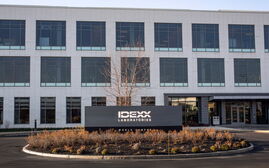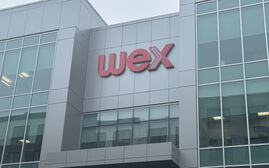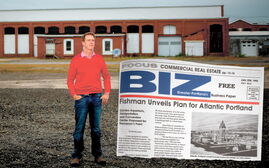Business leaders tell Maine forum: Lessons of COVID-19 are here to stay
 Screenshot / World Affairs Council of Maine
Kevin Therrien, senior director of worldwide supply for Westbrook-based IDEXX Laboratories, predicted transportation redundancies, inventory stockpiling and remote and hybrid working will help avoid future business disruptions.
Screenshot / World Affairs Council of Maine
Kevin Therrien, senior director of worldwide supply for Westbrook-based IDEXX Laboratories, predicted transportation redundancies, inventory stockpiling and remote and hybrid working will help avoid future business disruptions.
Transportation redundancies, inventory stockpiling and continued remote and hybrid working are all likely part of the future of the business world, in order to avoid the type of disruption that is occurring during this year’s pandemic. That's the prediction of corporate leaders who spoke in a Nov. 18 virtual forum, held by the World Affairs Council of Maine, about COVID-19 and the future of the global economy.
“I don’t think anyone fully predicted the global impact of the pandemic,” said Kevin Therrien, senior director of worldwide supply for Westbrook-based animal diagnostics maker IDEXX Laboratories Inc. (Nasdaq: IDXX) and a board member with the Maine International Trade Center in Portland. “By March, we were looking at a whole new way of working.”
Therrien cited resilience and agility as important business characteristics for maintaining supply chain network and operations.
“Resilience is how fast you can bounce back,” he said. “Agility is having more than one options when there’s a disruption.”
Having more than one distribution option “is critical to responding to disruptions that are becoming more and more common,” he continued.
Transportation constraints
He cited pandemic-related constraints on transportation as an example. A good portion of global air cargo is transported in the belly of passenger airplanes.
“So when passengers stopped flying, so did the cargo,” he said.
That constrained the global movement of goods, strained land- and ocean-based transportation providers, left cargo containers on the wrong side of the ocean, and delayed receipt and delivery of materials and goods, he continued.
“It’s amazing how long it takes to fix problems like that so materials can be brought in on time,” he said.
Therrien predicted that companies will start withholding inventory to hedge against delivery failures or delays, as opposed to the just-in-time production model common before the pandemic.
Some companies, he said, are talking about “near-sourcing” their operations – siting production closer to their supply chain – in order to mitigate transportation disruptions of the future, as opposed to longstanding outsourcing trends that send production to other countries.
Remote work
He predicted that remote and hybrid office work is here to stay and that, thanks to virtual communication capabilities, there will likely be a de-emphasis on geographic location for talent, which could create new opportunities for companies and employees.
Siemens AG found productivity went up when it sent employees home to work, said Dan Staples, vice president of Mainstream Engineering R&D, a division of the Plano, Texas-based Siemens Digital Industries Software business unit.
Siemens, a German multinational conglomerate that employs about 400,000 people, looked at their productivity a couple of months after implementing remote working.
“They were more productive,” Staples said. “That was a surprise.”
The company also found that 70% of employees preferred working at home, although they missed social interaction.
As a result, in July, Siemens decided that a large percentage of its workforce, about 160,000 people, would be doing “the new normal,” he continued.
“It’s no longer a five-day week in the office,” he said. “It will be two to three days in the office and two to three days at home.”
That arrangement will continue beyond the pandemic and will be part of the way the company will work from now on, he said.
Global talent
An interesting side effect, he continued, is being able to source talent working remotely from around the globe.
“What we’ve found, with this big social experiment, is that we do well remotely,” he said. “It’s becoming very normal for us to be on a Zoom-like call on a daily basis.”
Another side effect that was unexpected, he added, was the conversion of what had previously been conference calls into video calls.
“So in a way, it’s brought us closer as a team,” he said.
Staples predicted that the office sector of the commercial real estate industry will be hard hit by the “new normal.”
“We might not need as much office space as we used to,” he said. “Multiply that by hundreds of thousands of companies, and commercial real estate might not be what I’d want to be doing.”
Therrien predicted that, in the future, IDEXX, like Siemens, will pursue a hybrid office model. Rather than individual desk spaces, he said, that might include modifications to support virtual collaboration in conference-room settings equipped with remote communication capabilities.
Both Therrien and Staples spoke to the loss of in-person interaction and its potential effect on work culture.
Lack of in-person interaction, said Therrien, could impact the ability to build trust and relationships that are critical to moving businesses forward.
“We take for granted the relationships we had built before March,” he said. “That’s what‘s been able to sustain us through this period.”
Hiring new employees who don’t have a chance to meet colleagues in person will pose new challenges, he said.
Siemens has remained flat on hiring through the pandemic, said Staples.
“But as we come out of this and we start hiring again, I think onboarding will be 10 times harder,” he said. “It’s more than a job. It’s a culture. And transferring culture though Zoom is a whole lot harder than in person.”














0 Comments